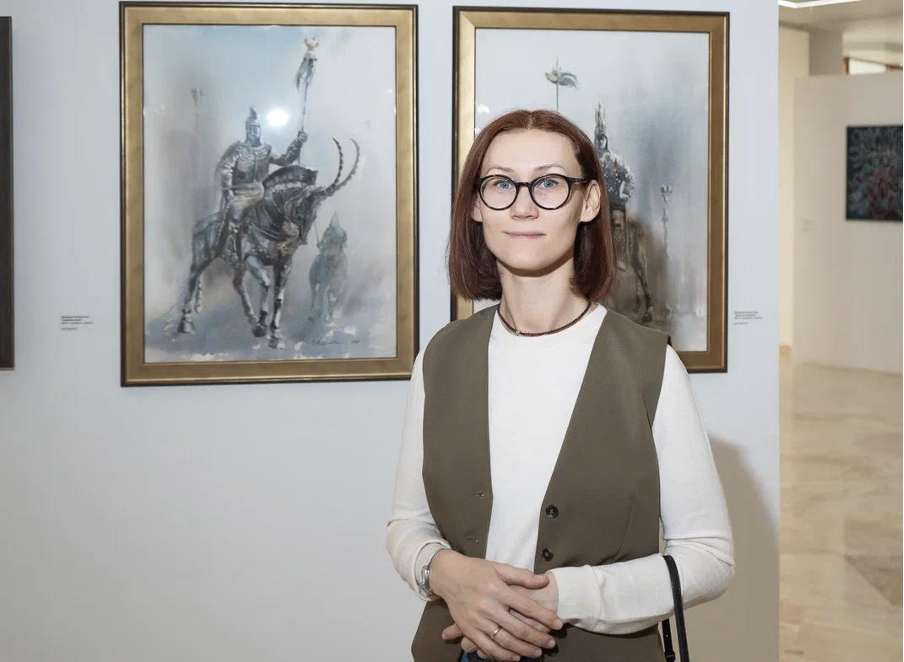
"I live on the Left Bank, and here, of course, there are construction sites everywhere, industrial landscapes. This was the focus of this series of works. I called it "Astana dual", meaning, as it were, two faces of the city. My concept was based on a peculiar view from two sides. I also went to the Right Bank, I was inspired by historical places. I also captured the new one that is being built now. It is interesting to watch how the city grows and develops, it changes every year, but at the same time there are some cozy, Tselinograd (Tselinograd is the old name of Astana) corners, too," Lizaveta Antropova noted.
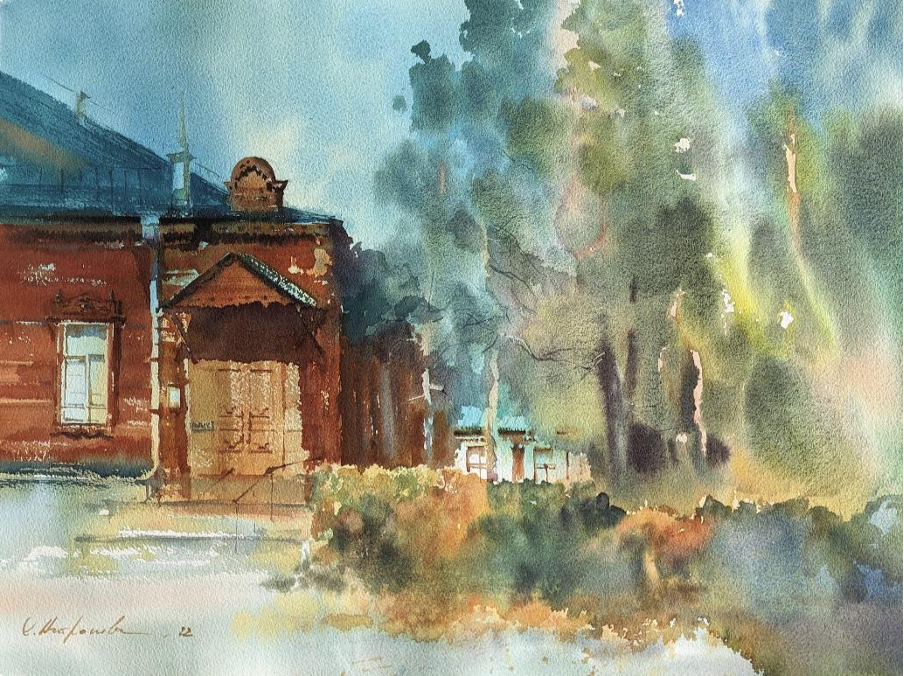
"S. Seifullin House Museum" from the "Astana Dual" series
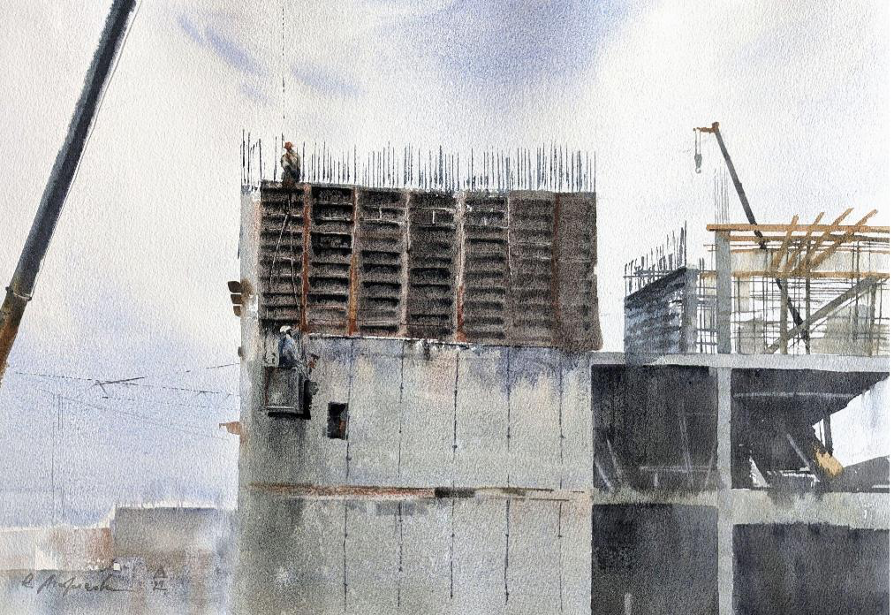
"Partners" from the "Astana Dual" series
By her example, Lizaveta Antropova shows that it is possible to be recognized as an artist without studying at the university. The author was born in Minsk and has been interested in creativity since childhood. For many years she worked as an image stylist, however, ten years ago she realized that she still wanted to connect her life with art. Wanting to start a creative career, Elizabeth decided to invest in knowledge. She took all kinds of courses and took private lessons from famous masters.
"I did not study at the university or at the academy. I didn't even go to art school. I studied everything on my own, our time now allows it. There are many possibilities on the Internet: both free resources and paid ones. I took courses in academic drawing, watercolor, and took private lessons from artists. Later, when she began to participate in international exhibitions and festivals, she held master classes and intensive workshops with various world-famous watercolorists. Of course, when you study directly with an artist, it speeds up the process very much," Lizaveta Antropova explained.
The choice of a novice artist was then made for watercolor. "This is a very convenient material, says Lizaveta Antropova, because it does not require a large workshop. In addition, watercolor has no smell, it does not stain furniture much, does not take up much space and it is very convenient to take it with you to the open air." Having embarked on the path of a watercolorist, Lizaveta discovered many techniques and techniques. At the same time, the author tried different materials: pastel, oil, and charcoal. However, it is watercolor that she likes now and she is not going to leave it yet.
"Of the famous watercolorists, I really like Alvaro Castanet, John Singer Sargent, Andrew Wyeth. There is also Nicolas Lopez, a young Peruvian artist who is very popular now. When I was just starting to get acquainted with watercolor, Sergey Kurbatov, a Russian artist who shoots online lessons, helped me a lot. His virtual classes are very simple and understandable for novice authors. He gave me an impetus, interested me, although now my style and my themes are something very far from him," Lizaveta Antropova shared.
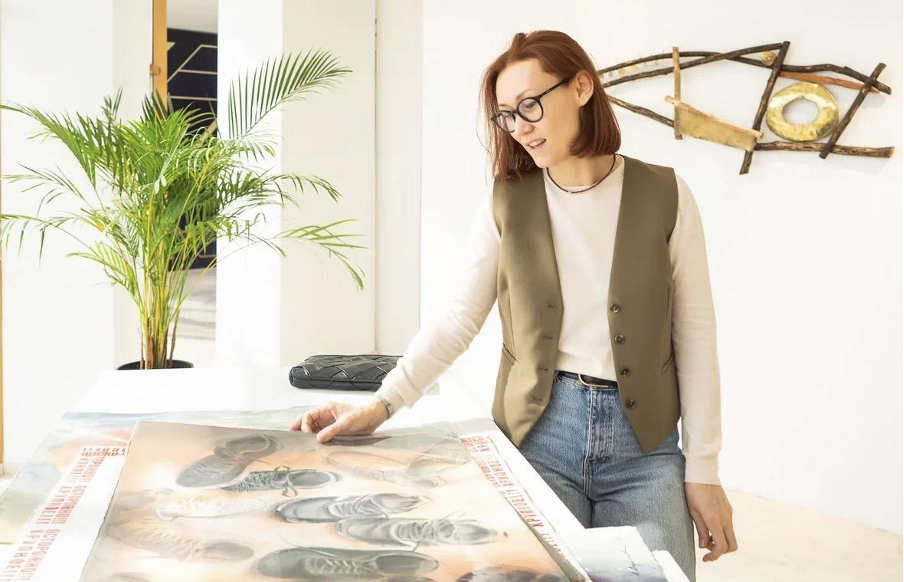
Lizaveta Antropova improved her skills in Turkey, Poland and India. Over time, the artist decided to try her hand at international exhibitions. At first, it was not easy to declare yourself on prestigious projects, because professional education was often required, but over time, people began to learn about Lizaveta and were willing to allow her to participate.
"It is important for an artist to participate in international projects, because all authors write differently. Styles, techniques, and themes differ from each other. At the exhibition, you see your work next to others and compare it, you immediately feel what you are missing and need to finalize. And you also see your strengths, so I try to participate as much as possible. 10 exhibitions a year is stable. Sometimes even more. Basically, these are offline, real exhibitions. Sometimes I participate online, as it was during the pandemic. Now I am already known as a watercolorist, and I exhibit in state museums. Even here in Kazakhstan, I participated in an exhibition dedicated to the 90th anniversary of the Union of Artists, first at the Kasteev Museum, and then at the National Museum. The National Museum took one of the works to its foundation, which is also nice," Lizaveta Antropova said.
In Kazakhstan, the artist has found like-minded people: sculptors, painters and graphic artists. One of the first people Lizaveta Antropova met was the metropolitan artist Evgenia Grekina. Together they held several local exhibitions and even tried to open a small workshop. Evgenia advised her to try her hand and offer her work to the prestigious Kazakh Center for Contemporary Art "Kulanshi".
"I knew that they have a large gallery and they hold many exhibitions. It is very difficult to get to them to exhibit, because they have a record for a year or two. In addition, their ForteBank Kulanshi ArtSpace gallery is very large. It is not easy for one author to fill it, especially with small watercolor works. However, Zhenya Grekina prompted me and insisted that I send them the portfolio by e-mail. They invited me to a meeting, and I came to them with my work. They liked the portfolio, and we agreed to hold an exhibition in a year. I just needed this year to prepare and complete the series," Lizaveta Antropova said.
The exhibition with the participation of Lizaveta Antropova at ForteBank Kulanshi ArtSpace took place last autumn. Along with her works, the exhibition includes the creations of a group of creative sculptors Qaz Sculpture Team and Marat Abishev. Lizaveta Antropova presented her works dedicated to Astana there. New buildings, cranes, views of the old city - all this turned out to be familiar to the capital's audience. It is noteworthy that in the collection of the artist there are paintings about Almaty, a city with a completely different energy, the author believes.
"Apart from Astana, so far I have only been to Almaty and Borovoye. I worked in the open air in Borovoye, it's very beautiful there, of course. But I also like to work with the urban landscape, to reflect the character of the city in paintings. You always want the person who lives there to look at the painting and feel that this is definitely his city. If we compare the works about Astana and Almaty, they are, of course, very different in mood, color, and some other points that I noticed. Almaty is a more cozy city, I think. The old architecture attracts, everything is compact. Here, in Astana, the landscapes are industrial, and the architecture is more restrained, more modern," Lizaveta Antropova noted.
Moving to Kazakhstan, Lizaveta believes, influenced her work. In the paintings of local artists, she was especially impressed by the bright color scheme and abundance of colors. The range of topics addressed by the author has also expanded. For the first time, for example, Saka warriors appeared on her canvases.
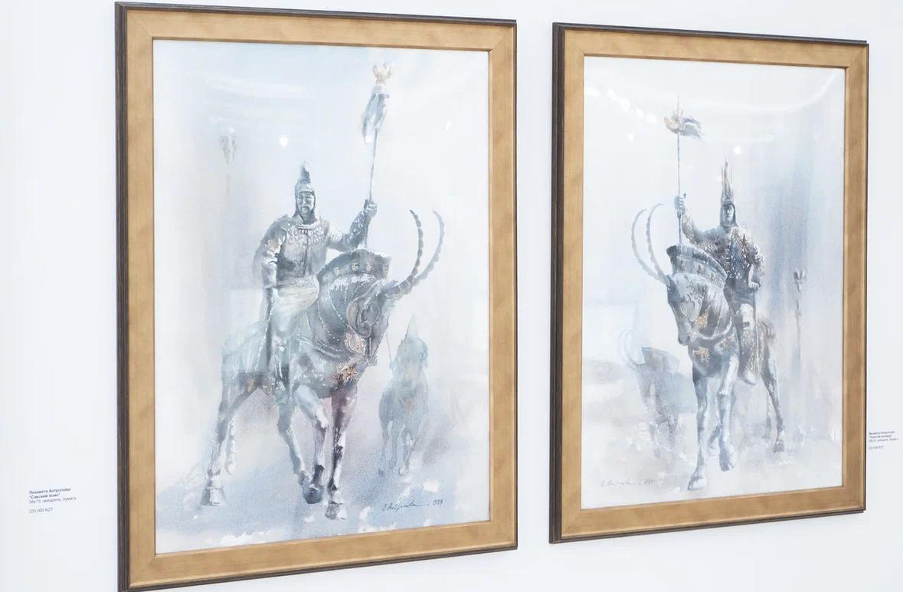
"Saka warriors"
"Initially, I saw them near the National Museum. There is a fountain "Saka warriors", it impressed me. I somehow got hooked on these images. I dedicated 4 paintings to them. Two of them, by the way, visited the exhibition in China. Now they can be seen here, in the metropolitan area. I have read about the Saka warriors, I know that they are the ancestors of the Kazakhs and occupy an important place in history. I was also impressed by the horses with horns, which were revered as mythological creatures. Many ornaments were found during excavations and are now kept in the National Museum. It is symbolic that now these works are hanging here next to exhibits from the private collection of Serzhan Bashirov, which represent elements of harness," Lizaveta Antropova said.
The artist follows the events and trends taking place both in Kazakhstan and around the world. Her work is a way to speak out, to share her opinion. In her creative collection there are both uncomplicated still lifes, urban sketches, and paintings that challenge and captivate the viewer with deep meaning.
"A woman is often faced with some kind of choice. Sometimes she has no choice, she may be limited in her rights. I once wrote a work that depicts women's dresses. Sometimes, after all, a woman can only choose what to wear, but she can no longer influence more. Another work is "Careful, fragile". It is connected with a high-profile court case that recently took place in Kazakhstan. I wrote it in the autumn, immediately after the murder of Saltanat Nukenova," Lizaveta Antropova noted.
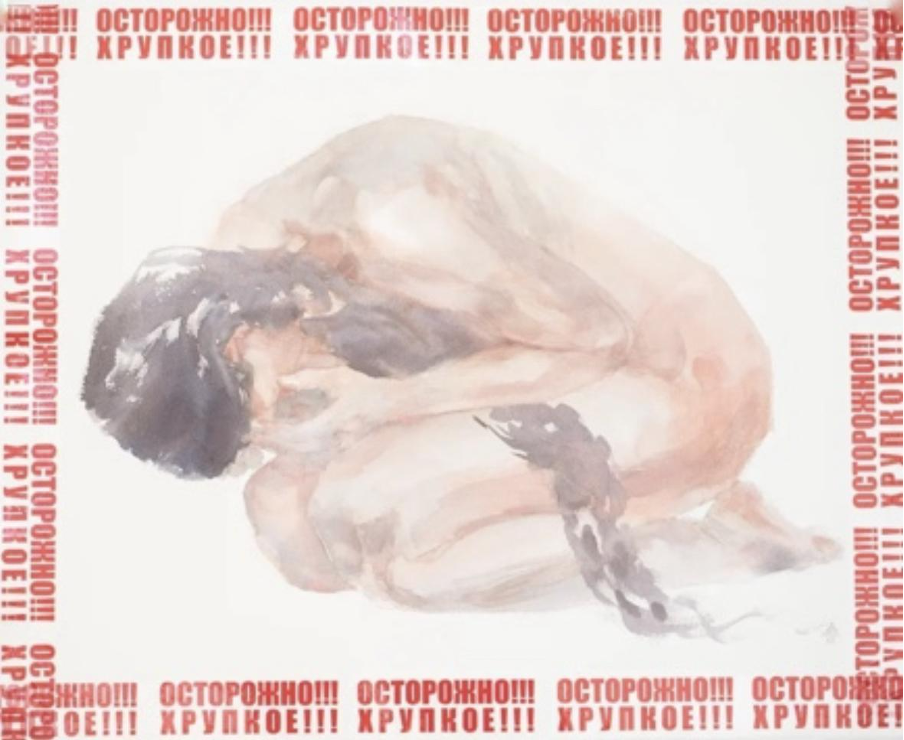
"Careful! Fragile!"
She devoted a separate series of works to the war in Ukraine. For Lizaveta Antropova, this is a personal story that touched relatives and friends.
"My dad and all his relatives are from Ukraine. Dad has already died, but all the relatives still live there, in the Dnipropetrovsk region, not far from the front. Of course, I was very impressed, especially at the beginning, when everything unfolded quickly and tragically. Losing a house is always hard for a person. Then many artists reacted. I have a series of 6 works, and it's called "There was a House here." Now, however, these works can be attributed not only to the war in Ukraine. There are a lot of tragedies, wars, and cataclysms in the world today. A huge number of people are losing their loved ones, their homes, and these works are really relevant," Lizaveta Antropova shared.
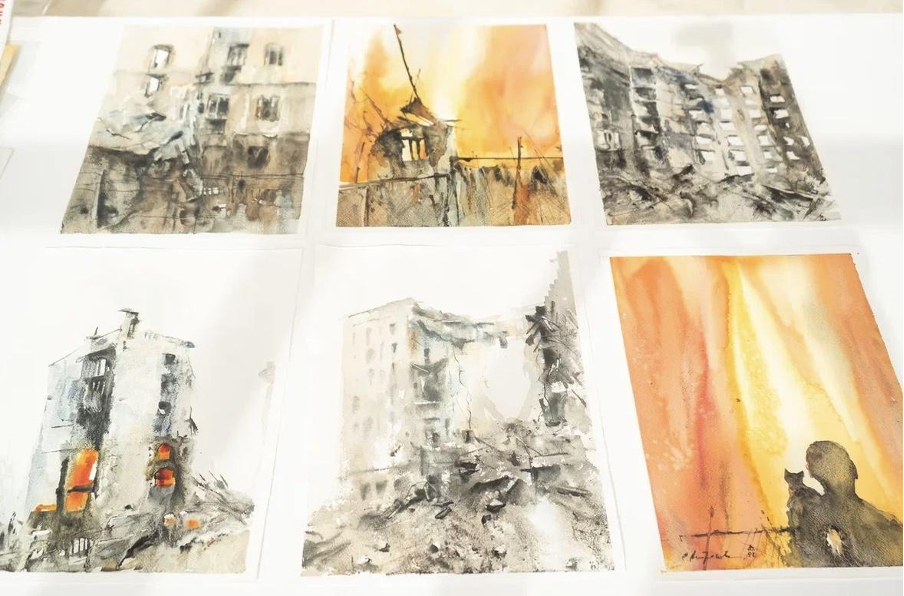
"There was a house here"
Elizaveta Antropova plans to develop the theme of her native home, its loss, and make a personal exhibition in Astana. In addition, the artist is a representative of the International Watercolor Community (IWS) and intends to develop the creative environment in Kazakhstan.
You can see some of Elizaveta Antropova's works in Astana in the Red Escalator art space at 2 Turkestan Street.









